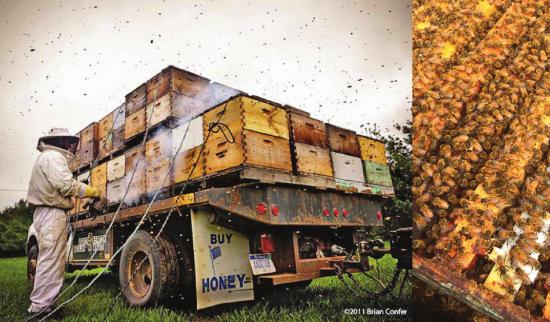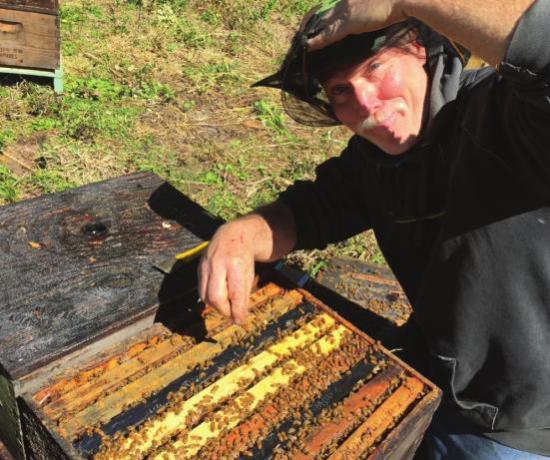Sleeping Bear Farm: A Year in Beekeeping
Aug. 27, 2015

Today, Kirk Jones is the owner of Sleeping Bear Farms honey operation in Beulah, where he presides over hundreds of hives, the bees that live in them and the products they make together, but his story really begins back on the bayou.
SOUTHERN INFLUENCE

Jones was first inspired by bees when he was a kid living in Louisiana.
"We spent a lot of time out in the woods and swamps," he explained. "I’d find hollow logs full of bees and they fascinated me."
He moved to Michigan as an adult in the ’70s and bought a log house in Honor as part of the back-to-the-land movement of the era.
"An old man from the area sold me two beehives when I moved in," Jones said. "I found that the bees did really well here."
The next year he started selling honey to the Oryana Food Co-op in Traverse City, "back when they were just an upstairs room on Front Street," he said. "So, they were actually my first customers!" In the late ’70s, Jones said there weren't a lot of jobs available in Benzie County.
"Still aren’t," he added. "So, I had to pioneer a job to fit the lifestyle that I wanted to have."
BEE-GINNINGS
That job turned into Sleeping Bear Farms, where Jones and his crew take every single thing the bees make and find a use for it.
"We like to say "˜from bee to bottle,’" Jones said.
Sleeping Bear’s most popular product is the simplest: raw honey. They also make honey spreads with fruit, honey mustard, honey wines and meads, and they sell wildflower honey, comb honey and beeswax.
The pure, snow-white beeswax is made from a special gland in the worker bee; the insects use it to construct honeycombs, which they then use for storing pollen, honey and raising brood (baby bees).
People use beeswax for cosmetics and candles ("its natural fragrance is very nice, even without scent added," Jones said); it’s actually more valuable than the honey itself.
"You only get one pound of beeswax for every 100 pounds of honey that you get," Jones said.
Jones’ wife Sharon has caught the bug, too. BeeDazzled, her business located in Benzonia, showcases products made from Sleeping Bear beeswax and mixed with olive oil and essential oils.
All of this, of course, begins with the bee.
POLLEN POWER
While they’re collecting nectar, bees pollinate along the way by transferring the pollen from one flowering plant to another, carrying it on their rear legs. This enables plants to reproduce; a 2014 CNN report said that bees pollinate more than 70 percent of the foods we eat.
Bees also eat some of the pollen they collect. Jones pointed out that pollen is made up of protein, minerals and vitamins, which makes it a well-rounded meal for bees.
"They bring it back to the hive, cover it with a bit of honey to preserve it, and eat it throughout the year," he said.
Pollen is not just pollen.
There are many different kinds, making a field or garden a little like a bee’s grocery store.
"There are different colors of pollen, with different levels of proteins and vitamins. Bees can tell which flowers have the best pollen," Jones said.
HONEY ORIGINS

Nectar, the base of honey, is separate from pollen, and Jones explained that bees find it more of a treat, like humans find sugar.
"They gather the nectar in their honey tank, which is kind of like a stomach, but not the kind we have," he explained.
When the nectar is first brought back to the hive, it’s weak and diluted.
"The bees add enzymes to it, store it in honeycombs and fan it with their wings," he said. "As the water evaporates, the nectar gets thicker and that's how we end up with honey."
Different flowers produce different honey flavors. Honey usually takes on the characteristics of whichever flower is most predominant near each particular hive.
"There are always some other flowers mixed in there, but in general it’s predominantly one flower," Jones said. "Right now, all the fields are full of purple flowers called star thistle," he said. "That makes star thistle honey, which is our most popular honey; it has the perfect balance of sweet and floral."
BUSY BUZZ
A good beekeeper with experience develops a sixth sense of his own as the seasons progress.
"All of your senses get tuned in to the scents and sounds of the hive," Jones said. "If the hive has a good queen and lots of food and they’re making plenty of honey, you’ll hear a nice, calm, low drone."
Jones and his crew even dress according to the bees’ mood. If the bees are busy with their duties, they won’t bother people, he explained. Gloves aren't usually worn unless the farm is actually gathering honey.
The honey is harvested once a year, from mid-August to early November. The honeycombs are removed from the hives and put into a large centrifuge-like mechanism that spins the honey out and separates it from the beeswax.
When it's cold and there’s no pollen to collect, the happy sound of busy bees changes.
"It’s more the buzz of an angry or worried bee," Jones explained. "It’s just different.
You hear that and you know that something’s not right."
Part of Jones’ remedy for bees that can't handle the colder weather is to quite literally send them on vacation. After the honey is harvested each season, the health of the bees is checked, some winter stores of honey are left in each hive, and they're shipped out of state for the winter, two-thirds to California and one-third to Florida.
SEASONAL ESCAPE
"Some of the bees come with us to Florida so that Sharon can start new hives," Jones said. "She takes some bees and puts them in a new box with a handpicked queen bee, kind of like you would with an heirloom tomato."
In the meantime, the Californiabound bees (taken care of by some of Jones’ associates) will keep busy pollinating the West Coast almond trees.
"We have them leave Michigan to remove stress," Jones said. "It helps the bees avoid Asian mites and the viruses that they carry, and obviously it keeps them out of the cold."
The bees vacation until mid- March, then return to Michigan to get back to work. It's a cycle that repeats every year: from the early days of spring through the busiest months of summer, to the honey harvest, the bee vacation and then back around again.
That’s exactly what Jones likes about the job he created for himself. It’s a year of work that's got a predictable pattern to it, yet that’s somehow never exactly the same.
"I’ve been working with bees for 35 years now," he said. "I really enjoy being outdoors, close to the earth.
You’re out with the bees as the different flowers bloom. You hear them working in the fields. You see the fresh white beeswax, the bees making new honeycombs."
"My favorite part is just that: getting the pulse of the seasons."
For more information on Sleeping Bear Farms honey, visit sleepingbearfarms.com or call 888-912-0017. Kirk Jones makes music, as well as honey; check out his band at benzieplayboys.com.
Trending

The Valleys and Hills of Doon Brae
Whether you’re a single-digit handicap or a duffer who doesn’t know a mashie from a niblick, there’s a n... Read More >>
The Garden Theater’s Green Energy Roof
In 2018, Garden Theater owners Rick and Jennie Schmitt and Blake and Marci Brooks looked into installing solar panels on t... Read More >>
Earth Day Up North
Happy Earth Day! If you want to celebrate our favorite planet, here are a few activities happening around the North. On Ap... Read More >>


